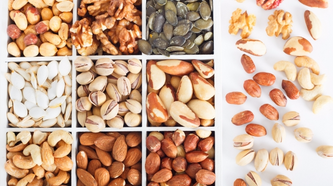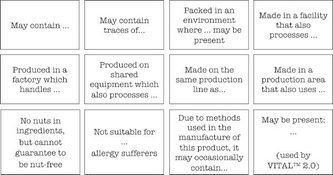How to classify the various kind of nuts? what are the common ones found in Dubai?
a collection of nuts available in Dubai
Nomenclature :
Tree nuts - include walnut, almond, hazelnut, cashew, pistachio and brazil nuts.
Peanut is not a tree nut, its a legume! other members of legume family: peas, beans, bean sprouts, lentils, and soya beans.
Coconut, is technically speaking a seed! though in USA its classified as a tree nut. Its not related to peanut or other tree nuts.
Sesame and Pine nuts: These are seeds . They share some similar allergens to peanut and tree nuts.
Lupin, is a seed that share similar allergens to peanuts.
Q1A) My son (Josh, 5yrs) has cashew nut nut allergy, does he have to avoid 'all nuts'?
FACT - NUT ALLERY CAN LEAD TO LIFE THREATENING ALLERGIC REACTIONS ! IT IS ONE OF THE LEADING CAUSES OF FATAL ANAPHYLACTIC REACTIONS IN YOUNG CHILDREN ACROSS THE WORLD.
Dietary avoidance is the only proven safe and effective management of peanut/tree nut allergy.
It is widely recognised that there is cross reactivity between various tree nut proteins. What I mean to say is that despite the fact that these tree nuts looking completely dissimilar to each other, yet their proteins (building blocks of a nut) can be quite similar and hence one may react to multiple tree nuts.
Studies have also shown that there is strong clinical cross reactivity between tree nuts and peanut in allergic individuals which means that clinically, patients are allergic to both tree nuts and peanut.
Children may also be advised to avoid treenuts because of the higher likelihood of cross-contact with other tree nuts/peanut during manufacturing and processing.
My Advice:
Young children who have never had any nut/peanut before their allergic reaction presentation, AVOID all nut/peanut products till they are reviewed by a Paediatric Allergist.
Q1B) Josh has cashew nut allergy but he had had hazel nut and pecan nut without any problems. Does he have to avoid hazel nut and pecan nut from now on?
NO ! he does'nt have to.
If Josh had up until recently been eating hazel nut and pecan nut without any problems, then he has an acquired tolerance to these tree nuts.You may continue to give him these tree nuts as before.
To decide whether he may be able to tolerate the other tree nuts and peanut - please discuss this with your Paediatric Allergist urgently . Josh may need further investigations (Skin Prick tests/ Blood tests for specific IgE to other tree nuts/peanut) before a decision can be made on whether he can take other nuts/peanut safely.
CAUTION: If you have been advised by an Allergist that it is safe to eat particular nuts, I would recommend that:
(a) they are only eaten if you are confident that they are not contaminated with other nuts known to cause a problem
(b) they are only eaten at home with emergency medication(anti histamine medication/Adrenaline auto injector) to hand and an adult present. This is because it is harder to be sure that any food containing nuts purchased and eaten outside the home is completely free from contamination by other nuts known to cause a problem.
Q1C) Will Josh outgrow his nut allergy?
It has been estimated that about 9% children eventually outgrow tree nut allergy as compared to 20% with peanut allergy.
Q1D) what can i do about 'may contain nuts' labelling on packaged food products?
examples of precautionary food warnings on food labels
This kind of labelling on packaged foods is called Precautionary Advice Labelling (PAL). These warnings are used by food manufacturers to highlight a possible risk of an otherwise nut free product being accidentally contaminated by nuts during manufacturing.
Pertinent issues to consider about PAL:
1) Studies have shown that a vast majority of foods with PAL did not contain evidence of allergen contamination.
2) Some studies have demonstrated that there is presence of allergen contamination in food products without PAL.
3) There is limited published data relating to allergic reactions due to cross-contamination (PAL related) and it is therefore extremely difficult to determine how common reactions due to unintentional cross-contamination are.
the real question over here is- 'what's the safest approach?'
My recommendation - Please take these labellings seriously!
Sweet and savoury snacks (e.g. cakes, biscuits, cereal bars, and crackers), confectionary and breakfast cereals are the foods most likely to be contaminated with nuts or seeds and should be avoided if they have a ‘May contain’ warning.
Chocolate or chocolate covered items with nut warnings should ideally be avoided.
AVOID if you have had a previous anaphylactic reaction to nut traces or “may contain” products.
I'm a paragraph. Click here to add your own text and edit me. I'm a great place for you to tell your story and let your visitors know a little more about you.
Latest comments
13.12 | 08:24
Extremely useful information with so many people now having allergies. This is so important for us all to know what to look for and what to do if we come across someone having a reaction. Thank you!
12.12 | 10:27
Excellent website. Loads of useful info. Well done Dr Verma.
29.11 | 05:00
Brilliant demonstration. Very clearly explained Dr Verma !!! Thanks
23.11 | 20:41
Definitely needed blog my nephew has a milk n egg allergy, i will signpost him to this blog as its written in a simple easy to understand way...
Share this page

